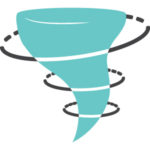
Tornadoes are common in the Midwest. These violently spinning columns of air, with rotating speeds that can exceed 200mph, can leave a destructive path more than a mile wide and several miles long. The St. Louis area is very susceptible to tornadoes. Even with improved warning times, it is critical to know how to quickly respond when the warnings go out.
Tornado watches are issued when weather conditions are favorable for the development of tornadoes in and close to the watch area. Watch areas are typically large and may cover multiple counties or even states.
Tornado warning: issued when a tornado or funnel cloud has already been spotted, or if there are radar indications that a tornado may be possible. Seek shelter immediately.
How to prepare before it happens
- Know where the best area of refuge is for your work area. It is typically the lowest, most interior space readily available. When identifying your area, try to avoid doors, windows and outside walls. Examples include basements, inside hallways or interior rooms.
- Keep at least one flashlight with extra batteries on hand.
- Keep at least one battery operated radio on each floor to use only in an emergency.
- Keep a NOAA weather radio at a location that will allow alerts from the radio to be heard by occupants in the work area.
What to do when it happens
- Seek shelter to the pre-designated area of refuge. Bring a flashlight and radio if accessible.
- Get under heavy furniture and protect your head and neck by covering them with your arms.
What to do right after it happens
- If the building has sustained damage, get out as safely as possible. Go to your Emergency Assembly Point.
- Report building damage and injuries to the appropriate emergency numbers:
- Danforth Campus: 314-935-5555
- School of Medicine: 314-362-4357
- North/West/South Campus & Tyson Research: 911 then 314-935-5555
- Be aware of new hazards created by the tornado such as exposed nails, broken glass, ruptured gas lines, etc.
- Do not touch power lines.
- Continue to monitor the radio.